Publications

NATO’s Nuclear Deterrent and Lessons from Ukraine
Russia’s invasion of Ukraine marks the first time in world history when a state uses its nuclear arsenal as coercive leverage in a war of conquest. The reverberations are felt throughout the world. Countries without an equivalent deterrent must question their chances of survival, should a similar fate befall to them. NATO, for its part, will have to review the requirements of deterrence and defence.
NATO has been a nuclear alliance since its inception. Its members are protected by the extended deterrence provided by the United States and the United Kingdom, alongside the independent deterrent of France. Neither Russia nor the Soviet Union has ever tested this deterrent with an overt military attack. On the other hand, Russia shares a land border with three European countries outside NATO’s defensive perimeter: Ukraine, Georgia and Belarus, all of which Russia has either attacked or managed to succumb under its dominance without war. Countries under the nuclear umbrella have been safe from aggression, while those outside the nuclear umbrella have not had the means to prevent themselves from becoming targets.
The effects of nuclear deterrence manifest every day. Nuclear weapons give their possessor greater freedom to maneuver and enact a foreign and security policy of their choosing. NATO’s Strategic Concept acknowledges this by assigning prevention of coercion as one of the fundamental tasks of its nuclear capability. The logic is simple. Coercive nuclear threats ring hollow if one has the power to respond in kind.
To grasp the importance of this task, one can ponder what the European response to Russia’s second invasion of Ukraine would have looked like if the concept and capabilities of extended deterrence did not exist. Without NATO’s nuclear capability, Russia’s coercion would likely have been much more effective and Ukraine’s fate dire.
Without NATO’s nuclear capability, Russia’s coercion would likely have been much more effective and Ukraine’s fate dire.
Yet, it would be premature to conclude that Russia’s coercion has altogether failed. Russia can claim a partial success, because even under NATO’s nuclear umbrella, many member states hesitated for a long time before supporting the delivery of advanced capabilities to Ukraine.
One could claim that hesitation was in fact responsibility in the face of the risk of escalation. However, it is worth contemplating whether supporters of Ukraine may have acted with greater confidence if Russia did not hold a significant advantage in theatre nuclear capabilities.
After the Cold War, the US withdrew almost all of its nuclear weapons from Europe. Only a small arsenal of B61 gravity bombs that are currently being modernised remains. The US also decided to retire the nuclear-tipped Tomahawk cruise missile in 2010. The reductions were based on post-Cold War logic that did not account for Russia as a serious military threat. At the same time, those hoping that Russia would reciprocate or that reductions would serve to reduce tensions have been proven wrong time and again.
Although Russia, too, reduced the size of its non-strategic nuclear arsenal in the 1990s and 2000s, it did so to a much lesser extent than the US. Currently Russia has an estimated 10:1 advantage over the US in non-strategic nuclear weapons. During the Putin era, Russia also begun the modernisation of this arsenal, and developed nuclear-capable high-precision weapons based on ground, naval and air platforms. The much-improved precision facilitates the use of lower yields for the purposes of calibrating the scope and effects of nuclear use. Russia has replaced its legacy systems with modern ones that are more usable in scenarios where the use of nuclear weapons is expected to be limited.
Consequently, Russia’s regional nuclear superiority allows it a certain coercive leverage on the lower rungs of escalation ladder. As Putin noted in June 2023, having more non-strategic nuclear weapons than NATO countries is Russia’s “competitive advantage”. Accordingly, if one of the tasks of NATO’s nuclear capability is to prevent coercion, the current composition of the US theatre nuclear forces may no longer be fit for purpose. If not reversed by the decisions of the US and possibly NATO, Russia’s nuclear superiority on a regional level will likely persist, with its attendant consequences. Arms racing or an increased reliance on nuclear weapons is not in NATO’s interest. Yet, removing Russia’s competitive advantage with a moderate enhancement of capabilities, including exercises, may well be.
Despite being an advantage, the war in Ukraine has again demonstrated that nuclear arsenals do not guarantee their owner a victory in war.
However, despite being an advantage, the war in Ukraine has again demonstrated that nuclear arsenals do not guarantee their owner a victory in war. It is not even uncommon that a nuclear power loses a war, as the US learned in Vietnam and the Soviet Union in Afghanistan. Nuclear weapons are unique in their destructive power, but their use is subject to a powerful taboo and is limited by the deterrent power of other nuclear forces, while taking and holding territory always requires ground forces.
Conventional military power, therefore, remains the bedrock of successful prosecution of high-intensity warfare. At the event of an invasion of one or more NATO-members, the Alliance would also rely on conventional forces. Although nuclear deterrence is the ultimate guarantor of the security of NATO, its greatest utility during war is facilitating victory by persuading the adversary that it is in its best interests that the war does not escalate beyond the level of conventional warfare.
Nuclear deterrence has historically caused discomfort for many in NATO. Russia’s imperialist war should, however, result in a sober assessment of the situation we find ourselves in. A strong nuclear deterrent makes NATO and its members more secure, and freer to act in the international arena.
GOING FORWARD:
» Russia’s use of nuclear weapons as a coercive tool in a war of conquest is a unique event in history that should result in a review of the requirements of deterrence.
» Nuclear deterrence is key to preventing nuclear coercion. States outside the nuclear umbrella live in a much more perilous world after Russia’s war of aggression in Ukraine.
» The US and NATO may need to invest in new nuclear capabilities to counter Russia’s advantage in theatre nuclear forces.
» Arms racing or greater reliance on nuclear deterrence is not in the interests of NATO. Deterrence and defence continue to require powerful conventional forces.
Jyri Lavikainen is Research Fellow in the Finnish Foreign Policy, Northern European Security and NATO research programme at FIIA. His research focuses on Russian foreign and security policy, nuclear deterrence and great power politics.
This article has previously been published as part of the Helsinki Security Forum 2023 report.

Helsinki Security Forum 2024 addresses the need for European total defence
The third annual Helsinki Security Forum (HSF) will be held on 27–29 September 2024. This year’s conference is titled Towards...

for HSF Blog
Rejecting Russian Spheres of Influence
The EU has rejected the language of spheres of influence in favour of an international order based on common rules...

for HSF Blog
Reverberations in the Indo-Pacific of the War in Ukraine
Russia’s war of aggression against Ukraine has had significant ripple effects in Indo-Pacific security dynamics and ongoing great-power competition.

About the author
Jyri Lavikainen
Research Fellow, FIIA
Jyri Lavikainen is a researcher in the Finnish Foreign Policy, Northern European Security and NATO research programme. His research focuses on Russian foreign and security policy, nuclear deterrence and great power politics. Lavikainen graduated from the University of Helsinki in 2016 with a Master’s degree in Political Science. He is a postdoctoral researcher at the University of Helsinki, where he is studying the development of the Russian concept of the struggle over the sphere of influence.